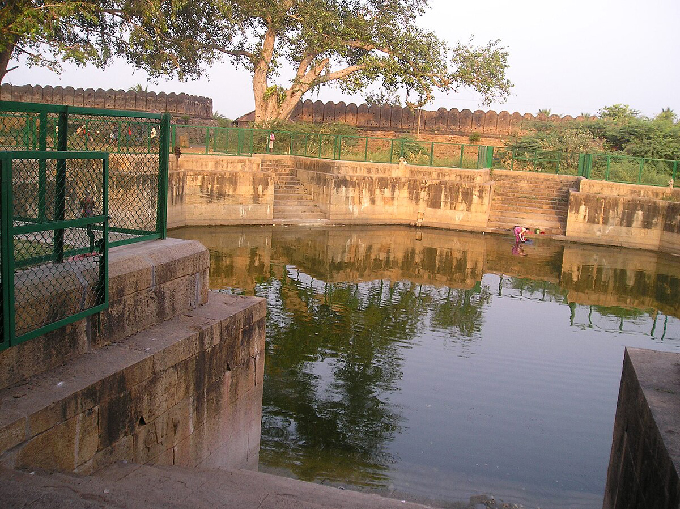108 Divya-deshams: Thirumayam
BY: SUN STAFF

Sathyamurthi Perumal Temple, Thirumayam
Jan 27, 2024 — CANADA (SUN) — A tour of the 108 Divya-desams, the divine abodes of Lord Vishnu and Lakshmi.
Sathyamurthi Perumal Temple in Thirumayam, a panchayat town in Tamil Nadu, is another Divya Desham dedicated to the worship of Lord Vishnu. Constructed in the Dravidian style of architecture, the temple is glorified in the Nalayira Divya Prabandham. The Lord is worshipped here as Sathyamurthi Perumal with His consort Ujeevana Thayar (Lakshmi).
The presiding Deity, Sathyamurthi Perumal, is approximately seven feet tall, standing on a rock along with His consort. In the next sannidhanam (sanctum), Mahavishnu's image is in sleeping position, called ari thuyil in Tamil, sleeping with a sense of knowing what is going on at present. Sculptures of Mahavishnu in this position can be viewed in many temples, although this is one of the largest examples. The reclining Deity is bigger than the Ranganatha image in Srirangam temple. At Thirumayam, Adishesha is known as a protecting force, once emanating fumes on the attacking asuras who wanted to destroy Him. The image is sculpted to show emanating flames.
There are many other sannidhis in the temple, all beautifully sculpted. The temple is set in a natural cavern which has been rockcut with various images. The hall preceding the sanctum, the ardha mandapa, is rectangular in shape, similar to the sanctum. The wall behind the presiding deity has images of Garuda, Chitragupta, Markandeya, Lord Brahma, the devas, the vasus, and the kinnaras.
The temple is believed to have been built during the 9th century by the Pandyas. A granite wall surrounds the temple, enclosing all its shrines. It has a five-tiered rajagopuram, the gateway tower and is behind a fort built during the 15th century. The temple tank is located inside the premises.
The Brahmanda Purana mentions the temple legend Adishesha, the serpent-mount of Vishnu, once wished to convert his guna (quality) from tamas (darkness) to satvik (purity). He performed penance at this place via the netherworld in a path which went on to become the river Pamapar. Vishnu appeared to him in the form of Hayagriva and granted him a boon. Chandra also performed penance at this place. Vishnu was pleased by his devotion and appeared to him in the form of Vamana.

The Temple tank of Thirumayam temple
A sage named Satya also performed penance at this place. Pleased by his devotion, Vishnu granted him a boon that he would appear to the sage whenever he wished. The sage had no wish to move away from river where he was performing the penance. Vishnu converted the river to a Pushkarani, the rock to Meyyam hill, and the banyan tree to Asvatta tree. The sage performed penance again and wished salvation. Vishnu told him that he would attain salvation at the same time as king Pururava. Vishnu then appeared in the form of a boar and created havoc in the kingdom of Pururava. The king chased the boar to the forest where the sage was performing penance. The sage was disturbed and opened the eyes, while the king saw the boar disappeared. Vishnu appeared to grant a vision to them both. He granted salvation to the sage and directed the king to build a temple at this place, which became Satyamurthi Perumal temple.
While many historians believe that the temple was built during the 9th century by the Pandyas, M.A. Dhaky places the period to be specifically the 7th decade of the 9th century. He has compared the images of the temple to that of Vijayalaya Choleeswaram in Narthamalai, built by Muttaraiyar kings during the same period. Another view is that the temple was built by a vassal of Pallavas following the Rock-cut architecture seen in the monuments at Mahabalipuram, built by Mahendravarman I (590-630 CE) and his son Narasimhavarman I. An inscription in the temple indicates contributions to the temple by Perumbidugu Perumdevi, mother of Sattan Maran, a contemporary and vassal of Pallava king Nandivarman II (731-796 CE).
The fort and nearby Sathyagiriswara Siva and Vishnu temples attract many visitors. The fort played an important role in the history of Thondaiman rulers of Pudukottai and the British. The 40 acre fort was built by Vijaya Ragunatha Sethupathi of Ramanathapuram in 1687 AD. On the hill, there is a rock-cut Shiva temple with inscriptions about music. There are relics of another fort. At the foot of the hill are the Shiva and Vishnu temples.

The view of the temple as seen from Thirumayam Fort
Wikipedia

The Sun
News
Editorials
Features
Sun Blogs
Classifieds
Events
Recipes
PodCasts
About
Submit an Article
Contact Us
Advertise
HareKrsna.com
Copyright 2005, 2024, HareKrsna.com. All rights reserved.

